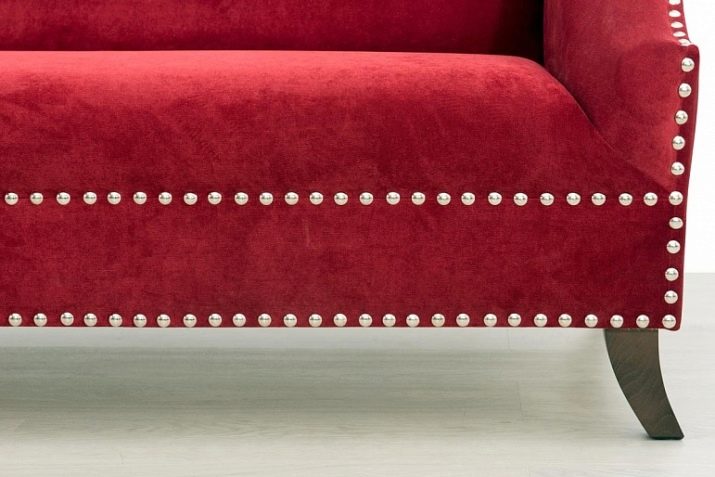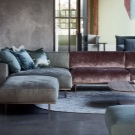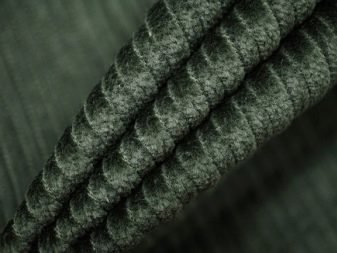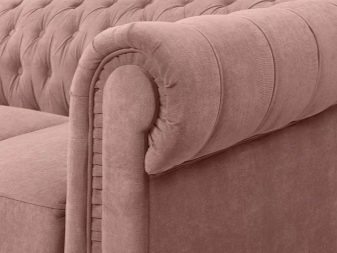What is micro-corduroy and how to care for the fabric?

Micro-corvette is a modern upholstery material that is in demand in the furniture industry. In the article we will talk about the advantages and disadvantages of the material, consider its description, application, features, and the nuances of care.






What it is?
Micro-corduroy is a soft, wear-resistant fabric with a characteristic striped pattern on the front side. It has a slight hairiness, reminiscent of the texture of velvet, looks noble and expensive. The textile has a dense structure and a complex twill weave of threads. It is produced using a special technology with the allocation of fleecy longitudinal fibers against the background of the rest of the threads. The seamy side resembles a canvas. The material is pleasant and warm to the touch, dyed in one color, varies in the composition of the raw materials used. It is one-sided, has a different direction of the pile, in order to avoid different shades, it is cut to one side.


Unlike corduroy, it has a minimal pile length. He has a little history. It dates back to the late 90s - early 2000s. The first producers were textile workers from China and India. When creating, several goals were pursued. One of them was to obtain a thinner material with better properties of velveteen, including velvety. It was necessary to create such textiles on which multicolor printing could be applied.
For production, machines were rebuilt, fabrics were woven from thin artificial threads. The resulting material was post-processed.


Production and composition
Modern material is produced on specialized equipment.The characteristic scars are created not during the weaving itself, but after the textile finishing (during the cutting of the loop overlaps). Initially, micro-corduroy fabrics were made from cotton. Later, when weaving, artificial fibers began to weave into the main fabric. The addition of polyester, viscose, polyamide makes the fabric more durable.

Thanks to artificial threads, it is possible to reduce production costs. Depending on the predominance of a particular type of raw material, the type of texture changes. On average, there should be no more than 10% viscose additives in the material. If the front side is matte, cotton prevails in the composition.
If there are a lot of synthetics in the composition, the front side is shiny. The more elastane or lycra is in the composition, the more the canvas stretches. Micro-corduroy itself belongs to the class of cotton fabrics. However, today completely natural types of canvases are extremely rare on sale. Most often, suppliers sell artificial fabrics.


Advantages and disadvantages
Micro-corduroy has a number of advantages.
- It is elastic and stretches well, thanks to which it can take the necessary form. Has tensile strength and resistance to mechanical stress.
- The fabric perfectly retains its original characteristics during intensive use. After stretching, it takes on its original shape. Has a long service life.
- It is safe for human health. Can be used by people with a particularly sensitive sense of smell and allergy sufferers. It is antistatic and dust-repellent.
- Micro-corduroy is inert to ultraviolet radiation. It does not fade when exposed to natural light for a long time.
- Differs in resistance to moisture, easy to color, aesthetically pleasing.
- The fabric has a budget cost. It lends itself to processing, does not crumble after trimming the edge. Moderately convenient to work with, it is considered a versatile material with good performance characteristics.


Along with this, it has several disadvantages.
- Shrinkage and maintenance difficulties are key. Some manufacturers have poor quality fabric. It gets dirty quickly.
- Varieties with synthetic fibers are resistant to shrinkage, but build up static electricity. Therefore, when using products, you have to use antistatic agents.
- Despite the wide range of colors and the durability of the preservation of the applied prints, with careless use, the material loses the integrity of the scars. Because of this, the fabric looks untidy.
- With a long stay in a humid environment, matter may increase its thermal conductivity.


Specifications
Micro velveteen has the smallest scar sizes. They are 1-1.5 mm wide. It has optimal hygroscopicity, amounting to 6-12%, depending on the type of texture. Capillarity (time of moisture absorption) in micro velveteen is less than average. It has low air permeability, but sufficient vapor permeability.
It is easy to handle as needed. It is produced in accordance with GOST 29298-2005. Printed fabric pattern, spinning method - pile. The main manufacturers are companies from Korea and China. There are 18-25 ribs on 1 inch of the canvas, which is almost 2 times higher than the values of traditional corduroy.
Compared to it, it has higher abrasion resistance. It does not irritate the skin.


Application
The use of micro-corduroy depends on its types. Soft types of fabrics are used in the production of clothing and accessories. Analogs with a less soft texture are used in the furniture industry, for sewing covers, decor. The fabric itself is considered dress, suit, blouse, upholstery.
Depending on the purpose, its colors can be neutral, muted, dark, bright. Basically, bright colors are typical for sewing clothes, dark and more practical canvases are used when covering furniture frames (backs, seats, armrests, elements of modular systems).



In clothes
Based on the density, thickness, pile size, micro-corduroy can be used for sewing women's, men's, children's clothing for various purposes. Micro-corduroy clothing looks austere and elegant at the same time. Today she is at the height of the fashionable wave. For example, not only suits, jackets, skirts, but also summer raincoats, work overalls, and bathing suits are sewn from micro-corduroy. In addition, it is used for sewing gloves and raincoats, which are gaining popularity today.
It makes beautiful casual and elegant dresses, trousers, shirts. From especially soft dense varieties, comfortable tracksuits and even dressing gowns are sewn, which warm the body until the heating season begins. Textiles can be the main and decorative material of products. For example, it produces spectacular inserts on lapels, flaps, pockets, and cuffs. The fabric goes well with other types of materials. Textiles go into the production of demi-season jackets, coats for men and women, and children's overalls. Headdresses are made of it.


In interior solutions
Micro-corvette is used in textile finishing of premises for various purposes. Stylish curtains, door curtains, wall decor are obtained from it. Office and home curtains made of micro-corduroy are unusual and practical. They do not let the sun's rays through, reliably hide everything that happens in the room from prying eyes from the street. It is used for upholstering furniture (sofas, armchairs, couches, banquets, poufs). Used for upholstery when it is necessary to change the upholstery to a new one.
The material is resistant to the claws of pets (cats, dogs and other pets). Due to the large assortment of colors, products from it can be selected for the interior of a specific style and color. It makes practical covers for different types of furniture, through which you can visually update old furniture.
Furniture fabric is resistant to abrasion, it lasts up to 10 years or more.



In other areas
Micro-corduroy is an excellent material for making bags. At the same time, the style and size of products can be very diverse. Also, this material is used for the production of shoes, car covers. Classic colors are black, beige, brown. Upholstery covers can be of different cut and shape. Micro-corduroy can decorate not only classic, but also sports types of covers.
It is the main and finishing raw material for their production. It is used for sewing car capes and bedspreads for sofas, ottomans, sofas. It can be a light blanket at the same time. In the skillful hands of craftswomen, micro-corduroy becomes the main raw material for sewing soft toys of various sizes and degrees of complexity. At the same time, the toys are distinguished by their novelty texture and pleasant tactile sensations.


Care rules
Micro-corduroy is one of the most demanding fabrics to care for. It does not withstand frequent intensive washings in the washing machine. It can only be washed in delicate mode. The washing temperature should not exceed 30 degrees. Removal of contamination should be timely, but not frequent. For cleaning, you need to use special detergents. Powders for machine washing differ from analogs for manual cleaning in less foaming. If you use them in a washing machine, you will not be able to completely get rid of the residues of the product. Therefore, manufacturers recommend using liquid substances for washing.
The spin must also be correct. Strong friction is detrimental to the texture of the front side. For this reason, twisting at high speeds is excluded. It is not recommended to crumple wet material too much.When washing, the product must be turned inside out. Hand wash is a priority. You can also dry-clean your micro-corduroy products. Do not wash micro-corduroy items together with items made from other fabrics.
The average wash time should be 15-30 minutes. The material cannot be bleached.

It is necessary to dry the matter in a natural way, without hanging it on heating radiators or heaters. It is important to ensure that the fabric is completely dry, but not dry out. This is harmful to its structure. The ironing mode is selected taking into account the instructions for a particular product. Some things do not need ironing. Others iron with steaming at temperatures up to 150 degrees, always through an iron on the seamy side. Some things are ironed in a suspended form. To do this, the product is hung on a hanger, straightened and steamed, practically without touching the surface of the fabric with the sole of the iron. Thus, strong creases that spoil the appearance are removed. With this processing method, large parts are first steamed, then small ones. If necessary, brush the pile with a soft brush.
It is better to store micro-corduroy items inside out in a dry, well-ventilated area. It is not necessary to wash only the stains, it is better to completely refresh the product. If it is impossible to wash the material, they get rid of the dust using ordinary wide adhesive tape. It is leaned against the fabric with the sticky side, then peeled off along with the dust. For non-removable upholstery, you can use a dry or damp clothes brush. However, you cannot rub the surface for a long time. If the dirt is heavy and stubborn, it is worth using a soapy sponge. After all stains have been removed, the surface is treated with a dry, clean sponge.










